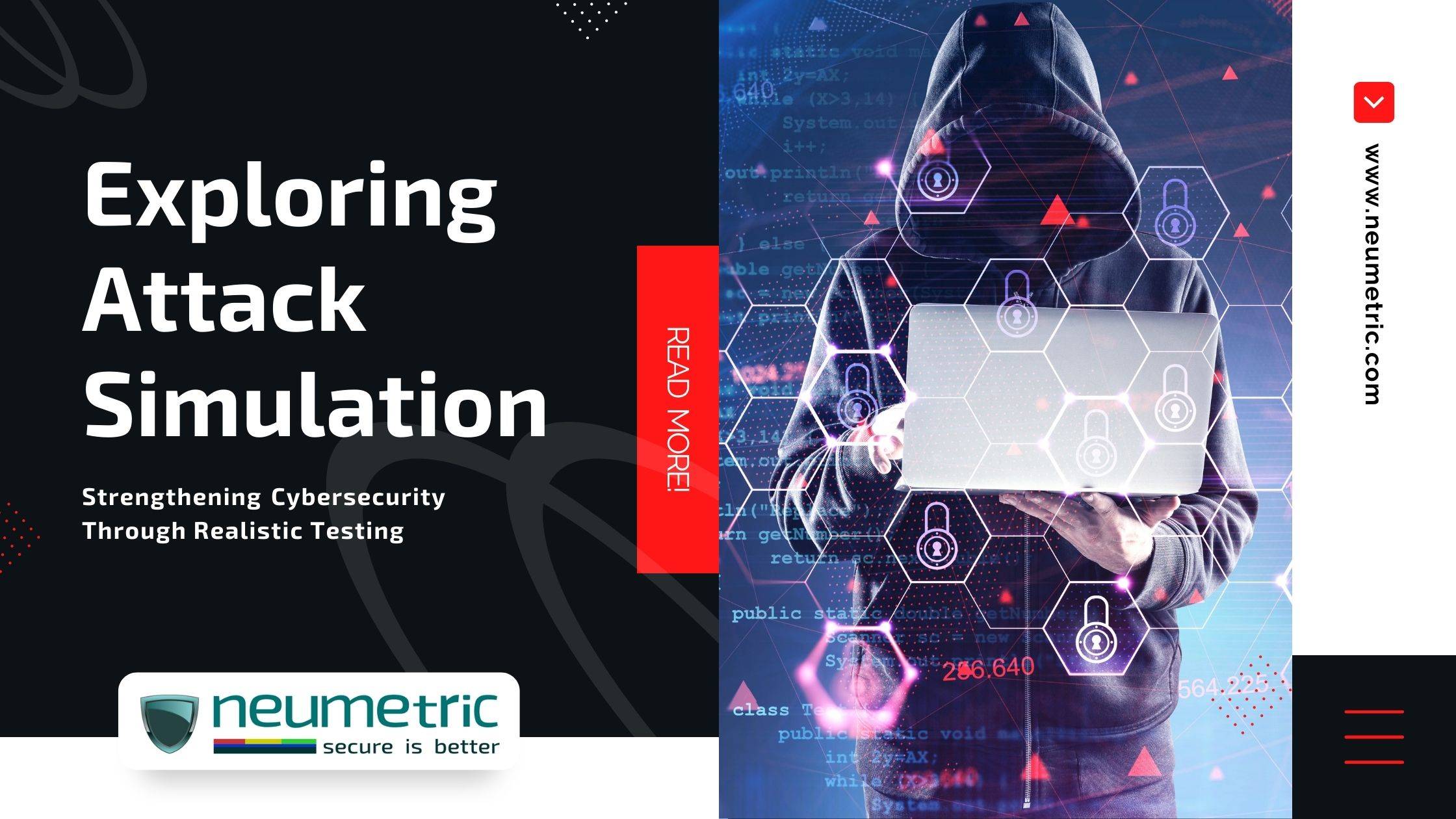Table of Contents
ToggleExploring Attack Simulation: Strengthening Cybersecurity Through Realistic Testing
Introduction
The escalating complexity & frequency of cyber threats have brought cybersecurity to the forefront of global concerns. From ransomware attacks paralysing critical infrastructures to sophisticated data breaches compromising sensitive information, the magnitude of these threats is undeniable. Traditional cybersecurity approaches, once effective against conventional attacks, now struggle to combat the rapidly evolving tactics employed by malicious actors.
In this context, attack simulation is prominent as proactive defence. Unlike reactive security, it looks ahead. Creating controlled attack-like situations helps find weaknesses, improve readiness & enhance incident response. This approach aligns with fortifying perimeters & anticipating breaches.
In the upcoming sections, the Journal will explore attack simulation. It will explain methodologies, benefits, challenges & ethical aspects. This exploration emphasises attack simulation’s importance in cybersecurity, enabling organisations to stay ahead of evolving threats.
Understanding attack simulation
Attack simulation creates controlled environments mirroring real cyber attack scenarios. Security teams execute simulated attacks, imitating malicious strategies. This helps organisations identify vulnerabilities, assess defences & refine incident response. Traditional cybersecurity focuses on theoretical vulnerabilities & known attack vectors, lacking in addressing emerging threats. Attack simulation tests an organisation’s resilience against new tactics, allowing proactive adaptation & breach mitigation.
Several techniques fall under the umbrella of attack simulation, each offering unique insights into an organisation’s cybersecurity posture:
- Red teaming: This involves deploying a team of skilled professionals to simulate sophisticated attacks, emulating the tactics of advanced adversaries. The objective is to identify vulnerabilities that automated tools might miss.
- Penetration testing: Also known as ethical hacking, penetration testing involves attempting to breach an organisation’s defences to uncover weaknesses. It aids in understanding potential points of failure & assessing the impact of successful attacks.
- Vulnerability assessment: This technique focuses on identifying & quantifying vulnerabilities within an organisation’s systems, applications & networks. It aids in prioritising security efforts based on the severity of vulnerabilities.
- Social engineering testing: This simulates attacks that exploit human psychology, such as phishing, to assess an organisation’s susceptibility to manipulation & its employee’s security awareness.
- Purple teaming: This collaborative approach involves both red team & blue team (defenders) working together. It fosters communication & knowledge sharing, enhancing overall cybersecurity posture.
Using these techniques, organisations get a comprehensive security view. Simulating real attacks offers insights beyond theory, proactively strengthening defences against evolving threats.
Key benefits of attack simulation
In the ongoing cyber battle, organisations aim to strengthen cybersecurity. Proactive attack simulation provides valuable benefits, enhancing overall security posture.
- Identifying vulnerabilities & weaknesses: One of the primary advantages of attack simulation is its ability to unearth vulnerabilities & weaknesses within an organisation’s security infrastructure. By emulating genuine attack scenarios, security teams can uncover hidden entry points that might not be apparent through traditional vulnerability scans. This process facilitates the identification of blind spots & aids in prioritising remediation efforts.
- Assessing security control effectiveness: Attack simulation serves as a litmus test for an organisation’s existing security controls. It provides a real-world context to evaluate the efficacy of firewalls, Intrusion Detection Systems [IDSs], access controls & other protective measures. Through this assessment, organisations can identify areas where their defences might fall short & make informed decisions about adjustments & improvements.
- Enhancing incident response capabilities: The realism inherent in attack simulation empowers organisations to refine their incident response capabilities. By simulating breaches, security teams can practise swift detection, containment & eradication of threats in a controlled environment. This practice strengthens the organisation’s ability to effectively respond to actual breaches, minimising potential damage & downtime.
- Gaining insights into threat scenarios: Attack simulation enables organisations to gain insights into potential threat scenarios & attacker techniques. This insight is crucial for understanding the evolving tactics of malicious actors. By mimicking these tactics, organisations can anticipate & prepare for new attack vectors, enhancing their ability to detect & thwart cyber threats.
The attack simulation process
- Planning & scoping
Attack simulation begins with thorough planning & scoping. Objectives, goals & desired outcomes are outlined. Crucial assets & potential attack vectors are identified. This sets the stage for scenario design aligning with security priorities, evaluating vulnerabilities & incident response. Clear planning ensures a focused, comprehensive simulation addressing unique challenges.
- Reconnaissance & analysis
In phase two, professionals gather info about the target. They learn about architecture, software & networking. This aids in identifying vulnerabilities & potential entry points. Analysis informs accurate attack scenarios, mirroring real threats closely. This info-rich phase ensures simulations match the organisation’s traits.
- Attack execution
The attack execution phase turns plans into action. Experts simulate real attacks, using earlier identified vulnerabilities. This includes phishing, malware & social engineering. The simulation tests defences, replicating actual threats. Teams gain real-time insights into control efficacy & response strategies, improving readiness against various attacks.
- Observation & data collection
In this phase, observation & data collection are crucial. Professionals monitor the simulation, recording each step. This captures valuable insights into progression, tactics & response. Data drives post-simulation analysis, identifying weaknesses & strengths. Capturing details aids decision-making & cybersecurity strategy refinement.
- Analysis & reporting
Post-simulation, analysis & reporting become key. Professionals scrutinise outcomes, evaluating controls & response. They assess vulnerabilities, successful attack vectors & response time. Detailed reports synthesise findings, offering insights & recommendations for better cybersecurity. Actionable insights allow organisations to enhance defences & responses based on real-world data.
Challenges & considerations
Attack simulation offers proactive cybersecurity potential but raises challenges & ethical concerns needing careful navigation for effectiveness & ethical use.
- Balancing realistic testing & disruption: Balancing realistic testing with operational disruption is a challenge. Complex simulations can unintentionally disrupt operations, affecting continuity. Designs should mirror real threats while minimising negative outcomes. Collaboration with internal stakeholders ensures simulations align with critical operations’ minimal impact.
- Legal & ethical boundaries: Ethical & legal aspects are vital. Simulating cyberattacks, even controlled, can breach legal or privacy limits. Proper permissions are crucial, especially with vendors or third parties. Adherence to ethical guidelines is essential, avoiding harm or data breaches.
- Addressing false positives & negatives: Attack simulations can have false positives & false negatives. False positives cause undue panic & resource use, while false negatives create a misleading sense of security. Teams must analyse results carefully, distinguishing real vulnerabilities from anomalies. Iterative testing & feedback refine simulations, enhancing accuracy over time.
Advanced attack simulation techniques
Cybersecurity evolves, influencing attack simulation techniques. Advanced methods use technology for sophisticated & effective simulations.
- Utilising artificial intelligence & machine learning for sophisticated attack simulations: Artificial Intelligence [AI] & Machine Learning [ML] elevate attack simulations. They create dynamic, lifelike scenarios mirroring threat behaviours. AI-driven simulations adapt based on defenders’ responses, mirroring real threats’ unpredictability. This aligns with cybercriminals using AI for attacks.
- Conducting continuous attack simulations for ongoing improvement: Given persistent cyber threats, organisations adopt continuous attack simulation. Regular, integrated testing updates defences against evolving threats. Continuous simulations identify vulnerabilities in real-time, reducing attacker opportunities.
Advanced attack simulation techniques offer accurate cybersecurity insights. AI, ML & continuous testing improve readiness against modern cyber threats’ sophistication.
Best practices for effective attack simulation
To optimise the value derived from attack simulations & elevate an organisation’s cybersecurity readiness, several best practices should be implemented.
- Collaborative approach: Adopt a collaborative strategy involving IT, security teams & management. This collective effort ensures a comprehensive assessment of potential vulnerabilities & facilitates the development of robust defence strategies. Collaboration encourages cross-functional knowledge exchange, empowering teams to collectively address security challenges.
- Continuous learning & adaptation: Treat attack simulations as learning opportunities. Continuously adapt & refine simulation scenarios based on outcomes & insights. Applying lessons from each simulation enhances security measures & response strategies, strengthening an organisation’s ability to anticipate & counter evolving cyber threats effectively.
- Integration with incident response & recovery planning: Integrate simulation outcomes into incident response & disaster recovery plans. The insights gained from simulations enhance these plans, ensuring readiness to mitigate potential breach impacts. This alignment bridges the gap between proactive testing & real-world preparedness.
By adhering to these best practices, organisations can optimise the potential of attack simulations. Collaboration, continuous improvement & strategic integration empower organisations to identify & proactively address vulnerabilities, bolstering cybersecurity defences within an evolving threat landscape.
Future trends in attack simulation
The realm of attack simulation is on the cusp of significant evolution, driven by emerging trends that are poised to reshape cybersecurity practices.
- Predictive analytics & threat intelligence integration: Anticipating threats is becoming paramount. The integration of predictive analytics & cutting-edge threat intelligence into attack simulations enables organisations to emulate emerging attack vectors more accurately. By leveraging historical data & real-time insights, simulations can offer a more authentic representation of evolving threats.
- Virtual & cloud-based attack simulations: The virtualization wave is extending to attack simulations. Cloud-based simulations provide scalability & flexibility, allowing organisations to replicate intricate real-world scenarios. These simulations enable organisations to assess their cybersecurity posture across diverse conditions, resulting in more comprehensive insights.
- Integration into employee training programs: Attack simulations are progressively becoming a cornerstone of employee training initiatives. Immersing employees in lifelike cyber threat scenarios enhances their preparedness & awareness. This integration transforms employees into a frontline of defence, capable of recognizing & effectively responding to potential threats.
These future trends promise to elevate attack simulations, ensuring they remain a vital strategy in fortifying cybersecurity defences against ever-evolving threats.
Conclusion
In a digital landscape rife with persistent & sophisticated cyber threats, the importance of attack simulation as a proactive cybersecurity strategy cannot be overstated. This Journal has explored the multifaceted benefits of attack simulation, from uncovering vulnerabilities to refining incident response protocols. By simulating real-world threats, organisations can anticipate, adapt & ultimately enhance their security posture in a rapidly evolving threat landscape.
As cyber threats continue to evolve, organisations are urged to embrace attack simulation as a regular practice. This dynamic strategy empowers them to continuously evaluate & improve their defences, staying ahead of adversaries. By incorporating attack simulations into their cybersecurity arsenal, organisations can not only bolster their readiness against potential breaches but also foster a culture of resilience & vigilance across all levels of their operations.
FAQ
What is an attack simulation?
An attack simulation is a controlled exercise that replicates real-world cyberattacks to assess an organisation’s cybersecurity defences. It involves ethical hackers mimicking malicious tactics to uncover vulnerabilities & weaknesses, enabling proactive mitigation.
What is a cyber attack simulation?
A cyber attack simulation is a strategic exercise where security experts emulate various cyberattack scenarios to evaluate an organisation’s readiness. It tests the effectiveness of defences, identifies vulnerabilities & enhances incident response capabilities against evolving threats.
What is the role of attack simulation administrator?
An attack simulation administrator oversees the planning, execution & analysis of simulated cyberattacks. They coordinate with security teams, define objectives, design scenarios, ensure ethical practices & interpret results to enhance an organisation’s cybersecurity preparedness.
What is simulation test in cyber security?
A simulation test in cybersecurity involves replicating real-world cyber threats within controlled environments. It assesses an organisation’s defences, response strategies & vulnerabilities. By simulating attacks like phishing or malware, these tests help organisations improve their security measures & incident response capabilities.





